AMD A10-5800K & A8-5600K Review: Trinity on the Desktop, Part 1
by Anand Lal Shimpi on September 27, 2012 12:00 AM ESTCompute & Synthetics
One of the major promises of AMD's APUs is the ability to harness the incredible on-die graphics power for general purpose compute. While we're still waiting for the holy grail of heterogeneous computing applications to show up, we can still evaluate just how strong Trinity's GPU is at non-rendering workloads.
Our first compute benchmark comes from Civilization V, which uses DirectCompute 5 to decompress textures on the fly. Civ V includes a sub-benchmark that exclusively tests the speed of their texture decompression algorithm by repeatedly decompressing the textures required for one of the game's leader scenes. And while games that use GPU compute functionality for texture decompression are still rare, it's becoming increasingly common as it's a practical way to pack textures in the most suitable manner for shipping rather than being limited to DX texture compression.
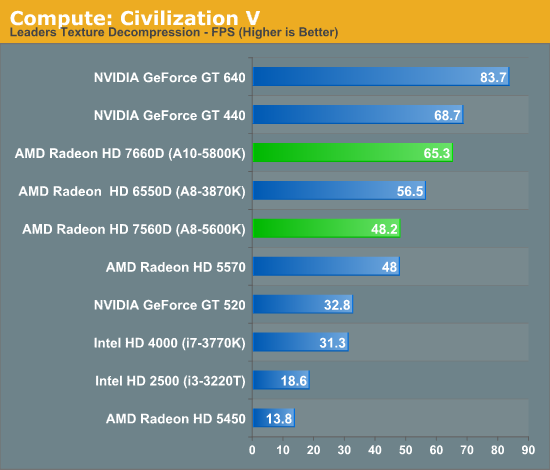
Similar to what we've already seen, Trinity offers a 15% increase in performance here compared to Llano. The compute advantage here over Intel's HD 4000 is solid as well.
Our next benchmark is SmallLuxGPU, the GPU ray tracing branch of the open source LuxRender renderer. We're now using a development build from the version 2.0 branch, and we've moved on to a more complex scene that hopefully will provide a greater challenge to our GPUs.
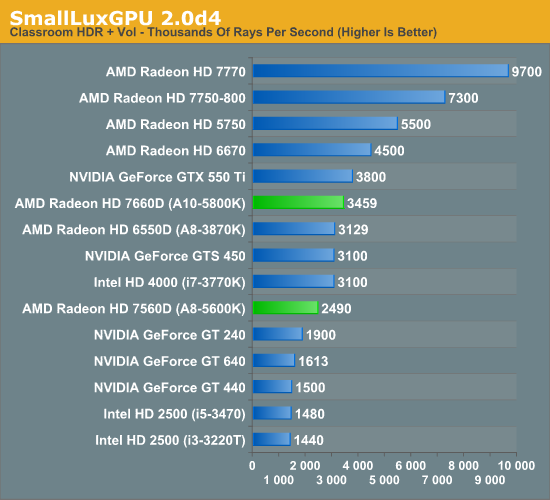
Intel significantly shrinks the gap between itself and Trinity in this test, and AMD doesn't really move performance forward that much compared to Llano either.
For our next benchmark we're looking at AESEncryptDecrypt, an OpenCL AES encryption routine that AES encrypts/decrypts an 8K x 8K pixel square image file. The results of this benchmark are the average time to encrypt the image over a number of iterations of the AES cypher. Note that this test fails on all Intel processor graphics, so the results below only include AMD APUs and discrete GPUs.
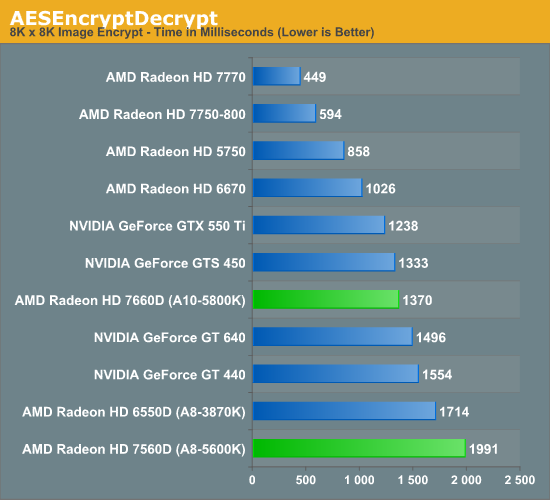
We see a pretty hefty increase in performance over Llano in our AES benchmark. The on-die Radeon HD 7660D even manages to outperform NVIDIA's GeForce GT 640, a $100+ discrete GPU.
Our fourth benchmark is once again looking at compute shader performance, this time through the Fluid simulation sample in the DirectX SDK. This program simulates the motion and interactions of a 16k particle fluid using a compute shader, with a choice of several different algorithms. In this case we're using an (O)n^2 nearest neighbor method that is optimized by using shared memory to cache data.
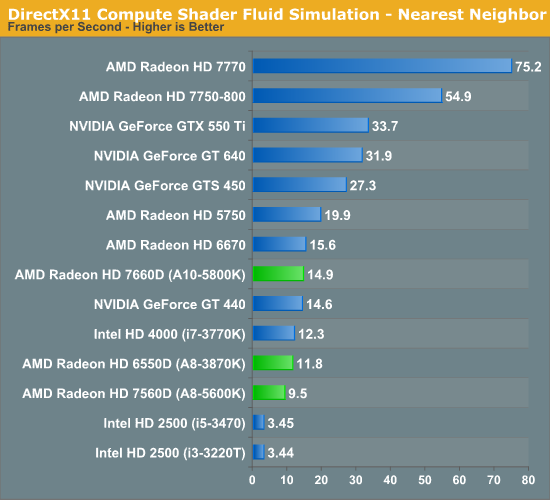
For our last compute test, Trinity does a reasonable job improving performance over Llano. If you're in need of a lot of GPU computing horsepower you're going to be best served by a discrete GPU, but it's good to see the processor based GPUs inch their way up the charts.
Synthetic Performance
Moving on, we'll take a few moments to look at synthetic performance. Synthetic performance is a poor tool to rank GPUs—what really matters is the games—but by breaking down workloads into discrete tasks it can sometimes tell us things that we don't see in games.
Our first synthetic test is 3DMark Vantage's pixel fill test. Typically this test is memory bandwidth bound as the nature of the test has the ROPs pushing as many pixels as possible with as little overhead as possible, which in turn shifts the bottleneck to memory bandwidth so long as there's enough ROP throughput in the first place.
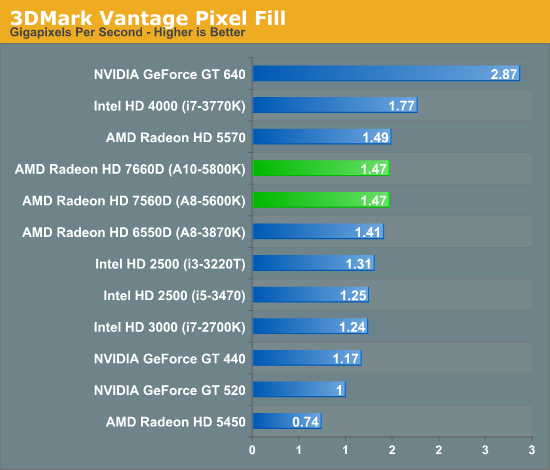
Since our Llano and Trinity numbers were both run at DDR3-1866, there's no real performance improvement here. Ivy Bridge actually does quite well in this test, at least the HD 4000.
Moving on, our second synthetic test is 3DMark Vantage's texture fill test, which provides a simple FP16 texture throughput test. FP16 textures are still fairly rare, but it's a good look at worst case scenario texturing performance.

Trinity is able to outperform Llano here by over 30%, although NVIDIA's GeForce GT 640 shows you what a $100+ discrete GPU can offer beyond processor graphics.
Our final synthetic test is the set of settings we use with Microsoft's Detail Tessellation sample program out of the DX11 SDK. Since IVB is the first Intel iGPU with tessellation capabilities, it will be interesting to see how well IVB does here, as IVB is going to be the de facto baseline for DX11+ games in the future. Ideally we want to have enough tessellation performance here so that tessellation can be used on a global level, allowing developers to efficiently simulate their worlds with fewer polygons while still using many polygons on the final render.
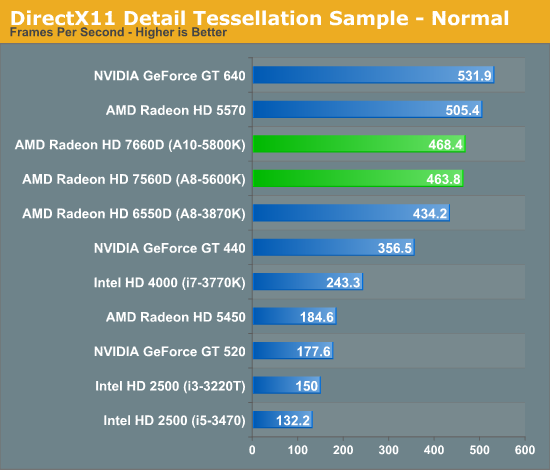
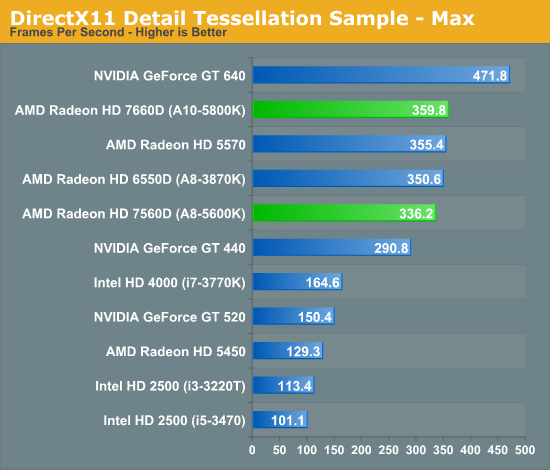
The tessellation results here were a bit surprising given the 8th gen tessellator in Trinity's GPU. AMD tells us it sees much larger gains internally (up to 2x), but using different test parameters. Trinity should be significantly faster than Llano when it comes to tessellation performance, depending on the workload that is.










139 Comments
View All Comments
ananduser - Thursday, September 27, 2012 - link
ARS ? Please... it's insulting to Anand to compare it to Ars. You're also insulting of Tom's. Techreport is better than them all as they've "innovated" in the benchmark area via microstuttering tests. You should read more and stop being so high strung about your fav sites.coder543 - Thursday, September 27, 2012 - link
don't know what side of the Internet you're from, but Ars Technica has some of the highest quality reviews of anywhere on the net. Anandtech is good, but they're heavily biased against both Linux and OpenGL, so that bothers me about them.Please, show me some of this low quality Ars material you speak of. I would also have you note that Ars and Techreport cross-post on occasion... so, praising one and not the other is a strange concept.
Tom's does *okay* reviews... but compared to Anandtech, their stuff is usually lacking.
ananduser - Thursday, September 27, 2012 - link
Oh please...Ars only knows mainstream. They cite more than they review. The only exception is Siracusa's yearly 100 pages OSX review which every Apple fan reads religiously and extensive Apple related coverage. Anand's, Tom's and Techreport are in a league of their own. Techreport recently impressed me with their "into the second" approach to benchmarking.Wolfpup - Friday, September 28, 2012 - link
Biased against Linux and OpenGL? How so? There's not much stuff USING OpenGL anymore, but that doesn't mean they're biased, and most people, even enthusiasts like most people here, aren't running Linux, sooo again doesn't mean they're baised against it.rarson - Wednesday, October 3, 2012 - link
Ars Technica is a freaking joke in everything that they do.medi01 - Thursday, September 27, 2012 - link
No other site uses 1000 Watt power supplies when testing HTPC CPUs either....damianrobertjones - Thursday, September 27, 2012 - link
...Unless it's Apple hardwaremattlach - Thursday, September 27, 2012 - link
I don't trust Tom's Hardware as far as I can throw them.After they were caught taking kick backs from hardware vendors for better reviews, and caught stealing content for their articles from other review sites, anyone who still reads that website is either a moron or ignorant.
Tomshardware wasn't bad back when Tom Pabst still ran it in the late 90s, but these days its a shell of its former self and completely and totally unreliable.
For me it's all HardOCP and Anandtech.
Homeles - Thursday, September 27, 2012 - link
You're going to have a very biased view of hardware if you only check two sources. I personally don't care for [H]ardOCP (I don't like their site design and the way they present their data), but AnandTech does try to keep things objective.Still, you can't pretend that AT is infallible and 100% trustworthy. If you do, then you deserve to be misled.
Like all media, it's best to check as many sources as possible before developing an opinion of something.
mikato - Monday, October 1, 2012 - link
Please link for the kickbacks! After reading this, I just searched Google for "tom's hardware kickbacks" and your comment was 3rd and the most relevant, lol. Need the info.